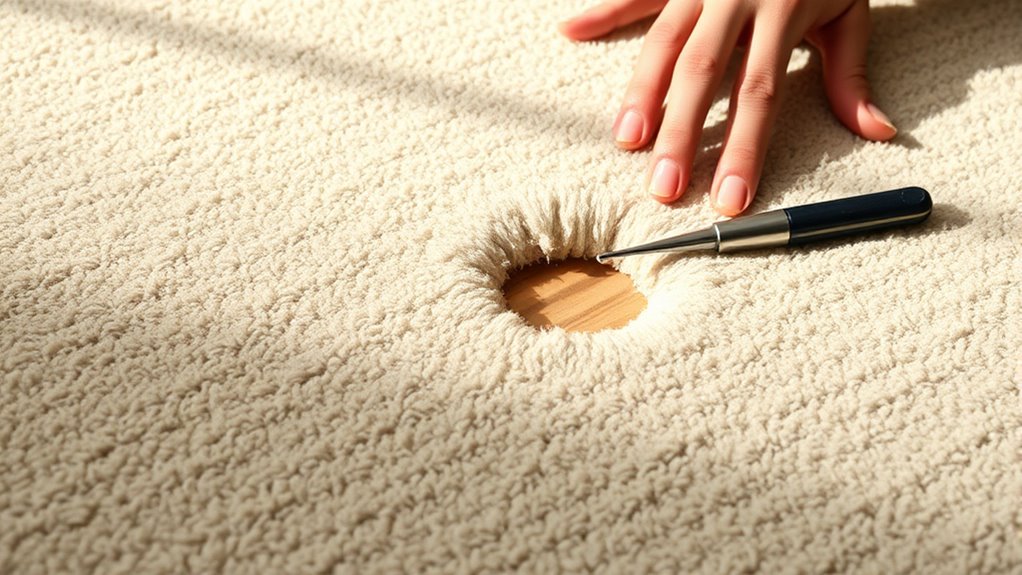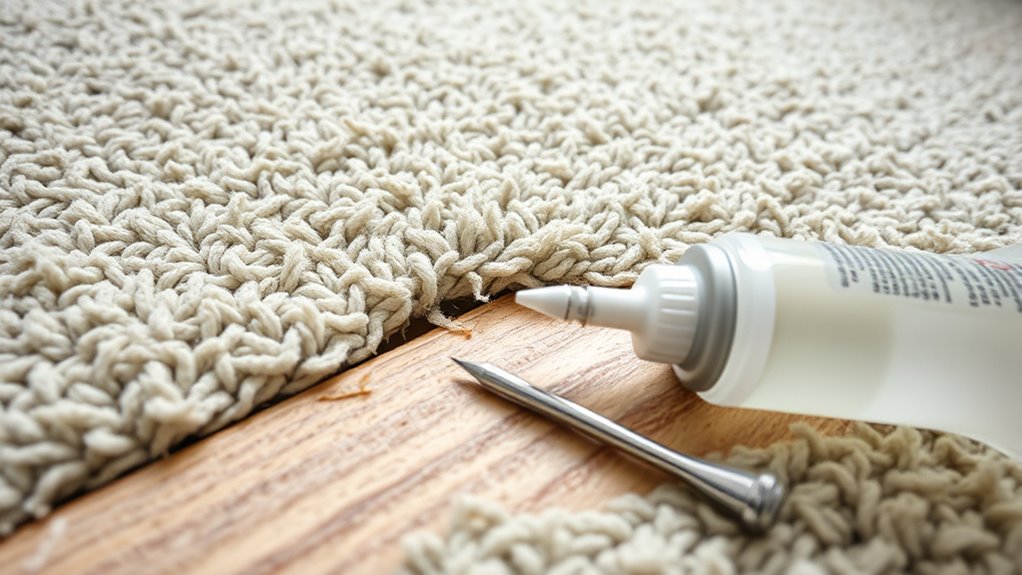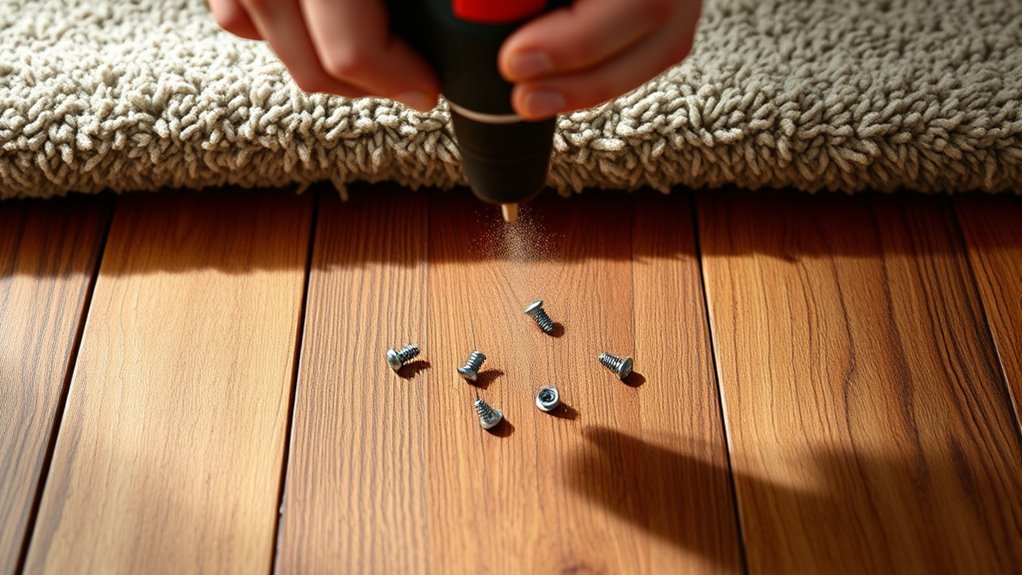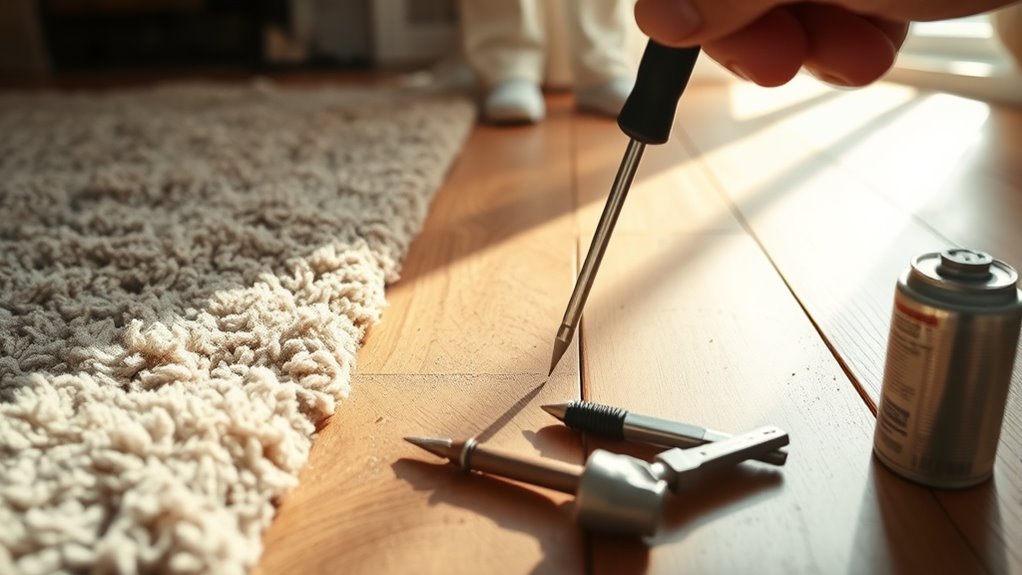To fix a squeaky floor under carpet, first pinpoint the noisy spots by walking slowly and applying pressure. Use a flashlight to check for loose floorboards or subfloor gaps through the carpet. Then, drive trim-head screws carefully through the carpet into the subfloor to secure loose sections without removing the carpet. You can also apply talcum powder between floorboards to reduce friction. For lasting results, you’ll want to explore proper tools, techniques, and preventative tips to keep your floor quiet long-term.
Identifying the Source of the Squeak

Where exactly is that annoying squeak coming from? Pinpointing the source requires you to detect specific floor movement causing sound amplification beneath the carpet. Walk slowly and deliberately across the suspect area, paying close attention to subtle shifts in the floor. The squeak results from friction between wooden floorboards or between the floor and joists, amplified by the carpet acting as a sound chamber. To isolate the exact spot, press firmly with your foot and note where the noise intensifies or shifts. You can also gently apply pressure with a blunt tool on the subfloor through the carpet to detect unstable or loose sections. Understanding this targeted floor movement is essential to direct your repair efforts efficiently, allowing you to restore quiet freedom to your space.
Tools and Materials Needed for the Repair
Successful repair of a squeaky floor under carpet depends on having the right tools and materials at hand. You’ll need a cordless drill, wood screws, a pry bar, and a stud finder to execute effective repair techniques. Depending on carpet types—whether plush, Berber, or low-pile—you might also require carpet seam adhesive or double-sided carpet tape to protect edges during the process. A thin putty knife helps in lifting carpet edges without damage, while wood shims or construction adhesive can secure loose subfloor sections. Don’t forget safety gear like gloves and eyewear. Selecting appropriate materials based on the floor’s construction and carpet type guarantees your repair lasts, granting you the freedom of a quiet, stable floor without unnecessary carpet removal or replacement.
Fixing Squeaks Without Removing the Carpet

To fix squeaks without removing the carpet, first pinpoint the exact noisy spots by walking over the floor. You can apply powder lubricants like talcum powder between floorboards to reduce friction. For persistent squeaks, drive screws carefully through the carpet into the subfloor to secure loose boards.
Locate Squeaky Areas
Although you won’t be removing the carpet, you’ll still need to pinpoint the exact spots causing the squeaks. Begin with a thorough carpet inspection, focusing on areas where squeaky noises occur most frequently. Walk slowly over the floor, applying pressure with your feet to reproduce the squeaks. Mark these locations discreetly using painter’s tape or small pins. If the noises are faint, try shifting your weight or hopping gently to isolate problematic spots. Avoid guessing; precise identification guarantees effective repairs without unnecessary disturbance. Use a flashlight to check for visible signs of loose floorboards or subfloor gaps beneath the carpet’s surface, if accessible. By accurately locating squeaky areas, you’ll target fixes efficiently, maintaining your freedom to repair discreetly without lifting the carpet.
Use Powder Lubricants
One effective way to reduce squeaks without lifting the carpet is by applying powder lubricants between the floorboards. You’ll want to select appropriate powder types, such as talcum powder, powdered graphite, or powdered soapstone, all known for their dry lubrication properties. First, identify the squeaky spots and loosen the carpet slightly if needed. Use a narrow tube or a powder applicator to distribute the lubricant evenly into the gaps between floorboards. The lubrication technique relies on reducing friction where wood planks rub together. After applying, gently work the floorboards to help the powder settle into joints. This method preserves your carpet’s integrity while effectively minimizing squeaks, granting you freedom from noisy floors without invasive repairs or expensive replacements.
Apply Screws Through Carpet
Secure the squeaky floorboards by driving screws directly through the carpet into the subfloor. Choose appropriate screw types like trim-head or drywall screws to minimize carpet damage and offer strong grip. Before you start, place a thin piece of cardboard or a carpet protector under the screw to avoid snagging or tearing fibers. Drill slowly and carefully to maintain carpet protection and avoid over-tightening, which could compress or damage the carpet pile.
- Regain freedom from annoying squeaks without removing the carpet
- Preserve your carpet’s appearance while fixing structural issues
- Use the right screw types for a durable, discreet repair
- Experience quick, practical results without major demolition
This method gives you control and efficiency while respecting your flooring’s integrity.
Securing Loose Floorboards From Above

When you notice squeaks coming from loose floorboards beneath your carpet, addressing the issue from above can be an effective solution. First, identify the exact squeaky spots by walking over the area. Different carpet types may affect your approach; thicker carpets can mask noise better but make locating squeaks harder. To secure loose boards, use trim-head screws long enough to penetrate the subfloor without damaging joists. Carefully fasten the boards through the carpet, ensuring minimal carpet damage and maintaining noise reduction. Countersink screws slightly to avoid carpet wear. Avoid excessive fastening to prevent carpet distortion. This method lets you fix squeaks without removing the carpet, preserving your flooring’s integrity and your freedom to maintain it efficiently.
Addressing Subfloor Issues Beneath the Carpet
Fixing squeaks from above the carpet can work for loose floorboards, but persistent noise often points to deeper issues in the subfloor. You’ll want to inspect the subfloor types—plywood, OSB, or planks—for gaps, warping, or damage. Moisture control is critical; excess moisture can weaken the subfloor and cause movement, so check for leaks or dampness before proceeding. Addressing subfloor problems involves securing loose panels with screws or adhesive and replacing damaged sections.
Persistent squeaks often signal subfloor damage—inspect, control moisture, and secure or replace panels for lasting stability.
- Regain control over your living space by eliminating hidden squeaks
- Prevent ongoing frustration caused by unstable flooring
- Enjoy a quiet, stable floor that supports your freedom
- Take practical steps that guarantee lasting repair, not just quick fixes
This approach lets you restore your floor’s integrity beneath the carpet efficiently.
Preventative Measures to Avoid Future Squeaks
Although you’ve addressed current squeaks, taking proactive steps is crucial to prevent new ones from developing. Effective squeak prevention hinges on consistent floor maintenance and structural checks. Regularly inspect joists, subfloor connections, and fasteners to catch loose components early. Maintain proper humidity levels to minimize wood expansion and contraction, which cause squeaks. Use appropriate fasteners and adhesives during repairs to guarantee lasting stability.
| Action | Frequency | Purpose |
|---|---|---|
| Inspect fasteners | Every 6 months | Tighten loose nails or screws |
| Check subfloor seams | Annually | Prevent gaps and movement |
| Control humidity | Year-round | Reduce wood warping |
| Reinforce joists | As needed | Strengthen weak spots |




